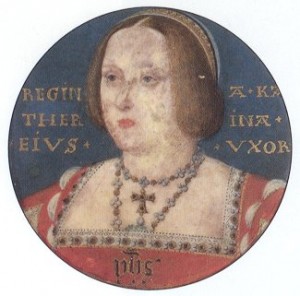 On 3rd July 1533, William Blount, Lord Mountjoy and Catherine of Aragon’s chamberlain, was instructed to inform Catherine that she was to stop referring to herself as ‘Queen’ and to recognise her title of Princess Dowager. Henry VIII’s marriage to Catherine had been annulled and his second wife, Anne Boleyn, was now Queen.
On 3rd July 1533, William Blount, Lord Mountjoy and Catherine of Aragon’s chamberlain, was instructed to inform Catherine that she was to stop referring to herself as ‘Queen’ and to recognise her title of Princess Dowager. Henry VIII’s marriage to Catherine had been annulled and his second wife, Anne Boleyn, was now Queen.
Here is an excerpt from the instructions sent to Mountjoy by Thomas Cromwell:
“As the King cannot have two wives he cannot permit the Dowager to persist in calling herself by the name of Queen, especially considering how benignantly and honorably she has been treated in the realm. She is to satisfy herself with the name of Dowager, as prescribed by the Act of Parliament, and must beware of the danger if she attempt to contravene it, which will only irritate the feelings of the people against her. If she be not persuaded by these arguments to avoid the King’s indignation, and relent from her vehement arrogancy, the King will be compelled to punish her servants, and withdraw her affection from his daughter. Finally, that as the marriage is irrevocable, and has passed the consent of Parliament, nothing that she can do will annul it, and she will only incur the displeasure of Almighty God and of the King.”1
After they had delivered the instructions from the King’s council to Catherine at Ampthill, Lord Mountjoy, Sir Robert Dymok, John Tyrell, Gryffith Richards and Thomas Vaulx sent the following report:
“To the effect that on Thursday, 3 July, they found her lying on a pallet, as she had pricked her foot with a pin, and could not stand, and was also sore annoyed with a cough. On our declaring that our instructions were to her as Princess Dowager, she took exception to the name, persisting that she was the King’s true wife, and her children were legitimate, which she would claim to be true during her life. To our assertion that the marriage with Anne Boleyn had been adjudged lawful by the universities, the Lords and Commons, she said the King might do in his realm by his royal power what he would ; that the cause was not theirs but the Pope’s to judge, as she had already answered the duke of Norfolk. To other arguments, that she might damage her daughter and servants, she replied she would not damn her own soul on any consideration, or for any promises the King might make her. She did not defend her cause upon obstinacy, nor to create any dissension in the realm, but to save her own rights; and as for the withdrawing of the King’s affection from her, she would daily pray for the preservation of his estate ; but as she sues by his licence, she trusts in so doing to lose no part of his favor. In fine, she will not abandon the title till such time as a sentence is given to the contrary by the Pope. She asked for a copy of these instructions, which she would translate into Spanish, and send to Rome.”2
The words “Princess Dowager” in the report were obliterated by Catherine, who obviously did not agree with the title being used. Catherine believed herself to be Queen and did not recognise the annulment or Henry’s second marriage; she would not submit and she would not be bullied. Henry may have got the annulment he wanted, but he could not force his first wife to accept it.
Catherine’s biographer, Garrett Mattingly, writes that Mountjoy was not happy with what he was being forced to do and “was already making up his mind that this was the last occasion on which he could be used to persecute the Queen, and that if his office of her chamberlain in which he had served her with loyal affection ever since her coronation was to be changed to that of jailer and inquisitor, he would lay it down, whatever the King’s displeasure.”3
Notes and Sources
- LP vi. 759
- Ibid., 760
- Mattingly, Garrett (1942) Catherine of Aragon, p264